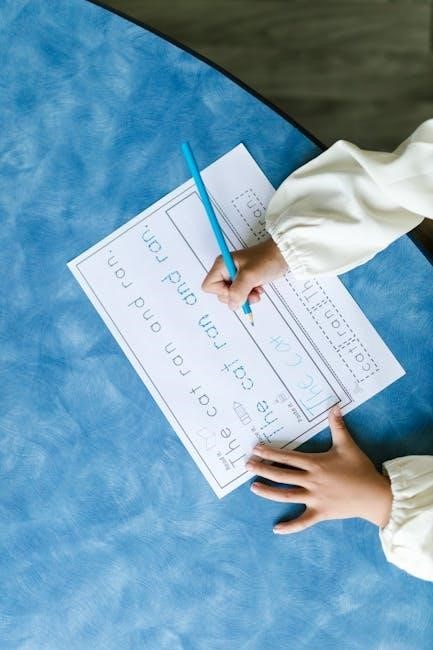First-grade reading worksheets are essential tools for developing early literacy skills. These PDF resources include engaging stories, comprehension exercises, and fun activities to boost reading confidence. Designed for young learners, they focus on phonics, vocabulary, and fluency, while aligning with curriculum standards. Colorful images and interactive elements make learning enjoyable, catering to diverse learning styles and supporting independent practice. Perfect for classroom or home use, these worksheets help build a strong reading foundation.
Overview of 1st Grade Reading Skills
First-grade reading skills focus on building foundational literacy abilities. Students learn to decode words, recognize sight words, and understand basic story structures. Phonics and decoding are emphasized, enabling children to read simple texts independently. Comprehension skills are introduced, with exercises on identifying main ideas, characters, and settings. Vocabulary expansion is a key component, with activities that enhance word recognition and context clues. Additionally, students begin to distinguish between fact and fiction and practice sequencing events. These skills are reinforced through engaging PDF worksheets, which include colorful images and interactive elements to make learning fun and effective. Fluency and confidence in reading are prioritized at this stage.
Importance of Worksheets in Reading Development
Worksheets play a crucial role in fostering reading development for first-grade students. They provide structured, engaging activities that reinforce phonics, vocabulary, and comprehension skills. By practicing with worksheets, students build consistency in their learning and develop confidence in their abilities. These resources also cater to different learning styles, offering a variety of exercises such as multiple-choice questions, true/false statements, and fill-in-the-blank activities. Worksheets encourage independent practice, allowing students to apply what they’ve learned in the classroom. Additionally, they serve as valuable tools for assessing progress and identifying areas where extra support may be needed. Regular use of worksheets helps create a strong foundation for lifelong reading skills.

Features of 1st Grade Reading Worksheets

First-grade reading worksheets feature colorful visuals, engaging formats, and age-appropriate content to captivate young learners. They include interactive elements, larger fonts, and activities tailored for beginning readers;
Types of Reading Exercises Included
First-grade reading worksheets incorporate various exercises to build foundational skills. These include phonics exercises, sight word recognition, and simple reading comprehension passages. Sequencing activities help students understand story order, while picture-word matching enhances vocabulary. Fill-in-the-blank sentences and word tracing activities improve writing and decoding abilities. True/false questions and multiple-choice quizzes assess understanding. Mazes and word searches add fun, reinforcing letter recognition. These exercises are designed to be engaging, helping young learners build confidence and fluency in reading. Each activity aligns with curriculum standards, ensuring comprehensive skill development.
Structure of Reading Comprehension Passages
Reading comprehension passages for 1st graders are short and simple, focusing on familiar topics. They often feature a clear main idea and supporting details, with basic vocabulary. Sentences are concise, making it easier for young learners to follow. Illustrations are frequently included to aid understanding and engagement. Each passage typically ends with questions that ask students to identify the main idea, recall details, or make simple inferences. The structure is designed to be consistent, helping students build confidence and routine. The length and complexity are carefully balanced to suit the reading level of early learners, ensuring a positive experience.
Benefits of Using 1st Grade Reading Worksheets
1st grade reading worksheets provide structured, engaging practice, fostering foundational skills, confidence, and a lifelong love for reading in young learners effectively and enjoyably.
Improving Reading Comprehension Skills
1st grade reading worksheets play a vital role in enhancing reading comprehension by introducing young learners to structured passages and guided questions. These exercises help students identify main ideas, characters, settings, and events in a story. Worksheets often include short texts followed by questions that prompt critical thinking, such as “What happened next?” or “How did the character feel?” This practice strengthens their ability to understand and interpret written content. Regular use of these resources builds confidence and familiarity with different text types, laying a solid foundation for advanced reading skills in later grades.
Enhancing Vocabulary and Fluency
1st grade reading worksheets are designed to expand vocabulary and improve fluency, essential skills for young readers. These resources often include word lists, definitions, and context clues to help students understand new words. Fluency is developed through repetitive reading exercises, such as reading aloud or following modeled readings. Worksheets may also incorporate rhyming games and word families to make learning engaging. By practicing regularly, students gain confidence in pronouncing words correctly and reading with natural rhythm. This foundational work ensures they can decode texts more smoothly and comprehend stories with greater ease, setting them up for success in future reading endeavors.
Common Themes in 1st Grade Reading Worksheets
1st grade reading worksheets often feature themes like friendship, family, animals, seasons, and community helpers. These relatable topics make learning engaging and fun for young readers.

Stories and Passages for Young Learners
Stories and passages in 1st grade reading worksheets are designed to captivate young learners with simple, engaging narratives. These texts often feature relatable characters, such as animals or children, and focus on everyday experiences like going to school or playing with friends. The language is carefully chosen to align with early reading skills, using repetition, rhyme, and predictable patterns to build confidence. Many passages are structured with clear beginnings, middles, and ends, helping students understand story structure. Additionally, these stories incorporate basic moral lessons or fun facts, making learning both enjoyable and meaningful. They are tailored to support curriculum goals while fostering a love for reading.
Aligning with Curriculum Standards
1st grade reading worksheets are carefully designed to align with curriculum standards, ensuring they meet educational goals for young learners. These worksheets focus on foundational reading skills, such as phonics, comprehension, and vocabulary development, which are central to 1st grade literacy standards. They incorporate exercises that support the progression from basic sight words to simple sentences, reflecting the expected learning outcomes. Many worksheets include activities that assess understanding of main ideas, characters, and settings, while others focus on fluency and decoding skills. This alignment ensures that the content is both developmentally appropriate and academically relevant, providing a structured path for skill mastery.
Types of Reading Comprehension Exercises
Worksheets include multiple-choice, true/false, and fill-in-the-blank activities to assess understanding, promoting critical thinking and vocabulary building in young readers.
Multiple-Choice Questions for Assessment
Multiple-choice questions are a popular feature in 1st grade reading worksheets, designed to evaluate comprehension skills effectively. These exercises present short passages followed by 3-4 answer options, allowing students to identify the correct response. They focus on understanding main ideas, supporting details, and vocabulary in context. The structured format helps young learners develop critical thinking and decision-making abilities. Visual elements, such as images, often accompany these questions to enhance engagement. Clear fonts and spacing ensure readability, making the activity accessible for early readers. These assessments also provide immediate feedback, helping teachers and parents track progress and identify areas for improvement. Worksheets with multiple-choice questions align with curriculum standards, ensuring comprehensive skill development.
True/False Questions for Fact Recall
True/False questions are a fundamental component of 1st grade reading worksheets, designed to reinforce factual understanding. These exercises typically follow short reading passages, presenting statements that students must label as either true or false. This format helps young learners develop accuracy in identifying key details and events within a text. Simple language and clear statements make the activity accessible for early readers. Visual aids, such as pictures or icons, often accompany these questions to provide context and support comprehension. True/False exercises also teach critical thinking skills, encouraging students to verify information before making judgments. They are an effective tool for assessing basic recall and understanding in a structured, engaging way.
Fill-in-the-Blank Activities for Vocabulary
Fill-in-the-blank activities are a popular feature in 1st grade reading worksheets, focusing on vocabulary building. These exercises present sentences or short passages with missing words, which students must complete by selecting the correct term from a list or recalling it from memory. This format helps learners understand word meanings in context and strengthens their ability to recognize appropriate vocabulary. Often, pictures or context clues accompany the blanks to guide young readers. Repetition of key words in different exercises reinforces retention. These activities are simple yet effective, making them an excellent way to introduce and practice new vocabulary in an engaging, hands-on manner.

Design and Layout of Worksheets
Design and layout of worksheets are visually appealing, incorporating images and clear structures to engage young learners and support their reading development effectively.
Visual Appeal and Engaging Formats
1st grade reading worksheets are designed with vibrant visuals and engaging formats to capture young learners’ attention. Colorful illustrations and relatable images make stories more interactive, helping students connect with the content. The layouts are clean and organized, ensuring readability while maintaining visual interest. Engaging formats such as puzzles, matching games, and sequencing activities are incorporated to make learning fun and interactive. These elements not only enhance focus but also create a positive association with reading practice. The combination of appealing visuals and creative formats motivates students to participate actively, fostering a love for reading and learning at an early age.
Use of Images to Support Text
Images play a crucial role in 1st grade reading worksheets, as they help young learners connect visuals with text. Pictures accompanying stories or passages provide context, making it easier for students to comprehend complex ideas. Illustrations often highlight key events or characters, aiding in understanding and recall. For early readers, images can bridge the gap between written words and their meanings, especially for vocabulary development. They also serve as prompts for discussion, encouraging students to describe what they see and relate it to the text. This dual approach of visuals and text enhances engagement and supports diverse learning styles, fostering deeper comprehension and enjoyment of reading materials.

Skills Developed Through Worksheets
1st grade reading worksheets help develop essential skills like comprehension, vocabulary, and fluency; They introduce critical thinking and build a strong foundation for lifelong reading enjoyment.
Phonics and Decoding Skills
1st grade reading worksheets emphasize phonics and decoding skills, helping students recognize sound-letter relationships and decode words. Activities include matching sounds to letters, blending syllables, and identifying word families. These exercises strengthen the ability to read unfamiliar words by breaking them into manageable parts. Worksheets often feature rhyming games, word sorting, and fill-in-the-blank tasks to reinforce phonemic awareness. By practicing these skills, students build a solid foundation for reading fluency and comprehension. The structured approach ensures mastery of basic phonics patterns, enabling young learners to tackle more complex texts with confidence.
Understanding Main Ideas and Details
1st grade reading worksheets focus on teaching students to identify the main idea and supporting details in a text. Through short, engaging passages, children learn to distinguish between central themes and specific facts. Activities include circling the main idea, underlining key details, and answering simple questions. These exercises help young readers develop the ability to summarize stories and understand the structure of written content. By practicing these skills, students improve their comprehension and begin to analyze texts more deeply. Worksheets often feature stories with clear main ideas, making it easier for first graders to grasp this fundamental reading concept and apply it to various texts.
Recognizing Fact vs. Fiction
1st grade reading worksheets often include exercises to help students distinguish between fact and fiction. These activities feature short passages, such as stories about talking animals or historical events, followed by questions that ask children to identify whether the text is based on real events or imagination. This skill is essential for developing critical thinking and comprehension. Worksheets may include true/false questions, labeling tasks, or sorting activities to reinforce the concept. By practicing this skill, young readers learn to analyze texts more carefully and understand the difference between factual information and creative storytelling, which enhances their overall reading comprehension abilities and prepares them for more complex texts in the future.
Worksheets for Diverse Learning Needs
Worksheets cater to diverse learning needs by incorporating visual, auditory, and hands-on activities. They support visual and auditory learners with images and read-aloud passages,
aiding English language learners with bilingual exercises and simplified language for better comprehension and engagement.
Catering to Different Learning Styles
1st grade reading worksheets are designed to cater to diverse learning styles, ensuring all students can engage effectively. Visual learners benefit from colorful images, charts, and diagrams that complement the text, while auditory learners thrive with read-aloud passages and rhyming activities. For kinesthetic learners, interactive exercises like fill-in-the-blank, tracing, and matching games provide hands-on practice. These varied approaches ensure that every child, regardless of their learning preference, can grasp reading concepts confidently. By incorporating multiple strategies, worksheets create an inclusive learning environment that fosters growth and understanding for all students.
Support for English Language Learners
1st grade reading worksheets often include features that support English Language Learners (ELLs), helping them build foundational reading skills. Worksheets may incorporate simplified language, repetitive phrases, and visual aids to make content more accessible. Images and culturally relevant themes help ELLs connect with the material, fostering understanding. Many worksheets include bilingual support or translation aids, allowing students to grasp new vocabulary and concepts in a familiar context. Interactive exercises, such as matching games or labeling activities, also help ELLs practice word recognition and sentence structure. These resources create a supportive environment for language acquisition, ensuring ELLs can progress confidently alongside their peers.

Accessing 1st Grade Reading Worksheets
1st grade reading worksheets are easily accessible online as PDF downloads, offering convenient printing and use for educators and parents seeking structured learning materials.
Free PDF Downloads Available Online
Free PDF downloads of 1st grade reading worksheets are widely available online, providing educators and parents with accessible tools for teaching foundational reading skills. These resources often include a variety of exercises, such as phonics practice, sight word recognition, and simple comprehension passages. Many educational websites offer curated collections of worksheets that align with curriculum standards, ensuring they meet learning objectives. PDF formats are convenient for easy printing and sharing, making them ideal for classroom or home use. By leveraging these free resources, teachers and caregivers can supplement lesson plans and support young learners in developing essential reading abilities. These worksheets are a valuable, cost-effective way to promote early literacy skills.
Recommended Websites for Worksheets
Several websites offer high-quality 1st grade reading worksheets in PDF format, making it easy to find and download resources. Education.com and Teachers Pay Teachers are popular platforms with extensive libraries of printable materials. Reading A-Z also provides leveled reading passages and activities tailored to young learners. These websites often categorize worksheets by skill level, ensuring they meet the needs of diverse learners. Many sites offer free resources, while others require a subscription for premium content. They are great for educators and parents seeking curriculum-aligned materials to support reading development. These websites are reliable sources for engaging and educational reading exercises.

Using Worksheets in the Classroom
Worksheets integrate seamlessly into lesson plans, providing structured reading practice. They facilitate group activities and independent practice, featuring interactive elements like matching games and puzzles, aligned with curriculum goals.

Integrating Worksheets into Lesson Plans
Worksheets can be seamlessly incorporated into daily lesson plans to reinforce reading skills. Teachers can use them as warm-ups, supplements, or homework assignments. By aligning worksheet content with current topics, educators ensure consistency and relevance. For example, phonics-focused worksheets can follow a reading lesson, while comprehension exercises can complement a story. They also provide structured practice, helping students apply what they’ve learned. Worksheets offer flexibility, allowing teachers to differentiate instruction for varying skill levels. Regular use helps track progress and identify areas needing extra support, making them a valuable tool for effective lesson planning and student development.
Monitoring Progress and Understanding
Monitoring student progress is crucial when using reading worksheets. Teachers can assess comprehension through completed exercises, identifying strengths and areas needing improvement. Worksheets provide immediate feedback, allowing for timely interventions. By reviewing answers, educators can track development over time and adjust instruction accordingly. This consistent evaluation helps ensure students grasp key concepts before moving forward. Parents can also use worksheets to monitor their child’s progress at home, fostering a collaborative learning environment. Regular checks help maintain momentum and ensure reading skills are solidified, making worksheets a valuable tool for ongoing assessment and tailored support.

Engaging Students with Interactive Elements
Interactive elements like puzzles and games make learning enjoyable and effective for 1st graders. These activities cater to various learning styles, ensuring all students stay involved and motivated.
Incorporating Games and Activities
Incorporating games and activities into 1st grade reading worksheets makes learning engaging and fun. Word-building exercises, matching games, and sequencing activities enhance phonics and vocabulary skills. Interactive elements like crossword puzzles or maze readers encourage active participation. These games often align with curriculum standards, ensuring educational value while keeping students entertained. Digital worksheets may include clickable exercises or audio features, making practice more dynamic. By integrating play-based learning, teachers can cater to diverse learning styles and maintain students’ interest. Such activities not only improve reading abilities but also foster a positive attitude toward learning, making the process enjoyable and effective for young learners.
Encouraging Independent Practice
Encouraging independent practice with 1st grade reading worksheets helps students develop confidence and self-directed learning skills. Worksheets designed for independent use often include clear instructions and self-checking features, allowing children to work at their own pace. Parents and educators can create a quiet, distraction-free space for practice, fostering focus and accountability. By gradually increasing the difficulty of exercises, students build resilience and a growth mindset. Independent practice also helps identify areas where additional support may be needed. Regularly reviewing completed worksheets ensures understanding and reinforces learning, making independent practice a valuable tool for overall reading development in young students.
Parental Involvement in Reading Practice
Parental involvement strengthens reading skills by creating a supportive environment for practice. Using 1st grade reading worksheets PDF, parents can guide and reinforce learning, fostering confidence and growth.
Guidelines for Home Use
Parents can effectively support their child’s reading development by establishing consistent practice with 1st grade reading worksheets PDF. Set aside dedicated time daily for reading activities, ensuring a quiet and distraction-free environment. Encourage children to read aloud and provide constructive feedback, focusing on pronunciation and comprehension. Use the worksheets to reinforce phonics, vocabulary, and fluency by discussing the content and asking open-ended questions. Positive reinforcement, such as praise for effort and progress, fosters confidence. Track improvement by reviewing completed sheets and celebrate milestones. This structured approach helps create a strong foundation for lifelong reading skills and a love for learning.
Reinforcing Learning Outside the Classroom
Reinforcing learning outside the classroom is essential for solidifying reading skills in young students. Parents can utilize 1st grade reading worksheets PDF to create engaging home learning sessions. Consistency is key; setting aside time each day for reading practice helps build a strong routine. Interactive activities, such as reading aloud or discussing stories, can make learning fun and effective. Parents should tailor their approach to their child’s pace and interests, ensuring the experience remains enjoyable and productive. Regular feedback and encouragement further motivate children to practice consistently. By integrating these strategies, parents can effectively support their child’s reading growth beyond school hours.
1st grade reading worksheets PDF are a valuable tool for building foundational skills and fostering a lifelong love for reading in young learners effectively.
Final Thoughts on the Value of Worksheets
1st grade reading worksheets PDF are indispensable tools for young learners, offering structured practice that reinforces essential reading skills. They provide a clear progression of difficulty, helping children build confidence and independence. By focusing on phonics, comprehension, and vocabulary, these resources create a solid foundation for future academic success. Their accessibility and affordability make them a practical choice for educators and parents. Consistent use of these worksheets can significantly enhance a child’s ability to understand and engage with texts. Ultimately, they serve as a bridge between learning and enjoyment, fostering a lifelong love for reading in a structured and supportive manner.
Encouraging a Love for Reading
1st grade reading worksheets PDF are designed to spark curiosity and excitement in young learners, making reading a joyful experience. By incorporating colorful images, engaging stories, and relatable characters, these resources help children develop a positive association with reading. Interactive elements, such as fill-in-the-blank activities and puzzles, encourage active participation and make learning fun. The variety of themes and topics ensures that children stay interested and motivated. Worksheets also allow parents and teachers to celebrate small achievements, fostering a sense of pride and accomplishment. This early exposure to reading can cultivate a lifelong love for books and learning, shaping their educational journey.